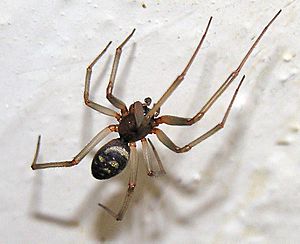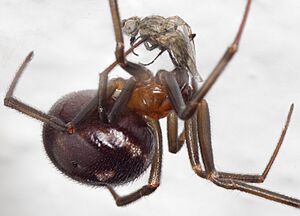Cupboard spider facts for kids
Quick facts for kids Cupboard spider |
|
|---|---|
 |
|
| Female | |
 |
|
| Male | |
| Scientific classification |

The Steatoda grossa is a common type of spider. People often call it the cupboard spider, the dark comb-footed spider, or the brown house spider (especially in Australia). It's also known as the false widow, but many other spiders share this name.
This spider lives in many parts of the world, like North America, Australasia, and Europe. It looks a bit like the black widow spider. Because of this, people sometimes confuse them.
Contents
What Does the Cupboard Spider Look Like?
Female Steatoda grossa spiders are usually 6 to 10.5 millimeters long. That's about the size of a pea! They are dark in color, often purplish-brown to black. They have a round body and some lighter markings.
Unlike black widows, these spiders do not have a bright red hourglass shape on their belly. This is a key difference.
Male spiders are usually 4.1 to 10 millimeters long. They are thinner than the females. Both sexes have similar colors. However, adult males often have lighter, reddish legs.
How Do They Grow?
Young spiders shed their skin up to six times as they grow. This process is called molting. They do this before they become adults.
These spiders can go many months without food. But they do need water to survive. A female spider that eats well can lay three or more egg sacs each year. Each sac holds about 40 to 100 eggs. The mother spider often watches her eggs closely. She stays with them for hours or even days as they get ready to hatch.
At normal house temperatures, eggs usually hatch within a month. The baby spiders are ready to live on their own right after they hatch.
How Long Do They Live?
Female Steatoda grossa spiders can live for up to six years. Males usually live for about 1 to 1.5 years. Males often die soon after they mate.
Where Do Cupboard Spiders Live?
Like other spiders in their family (Theridiidae), Steatoda grossa builds a cobweb. This is a messy tangle of sticky silk threads.
How Do They Hunt?
These spiders have very poor eyesight. They rely on vibrations in their web to find food. They also use vibrations to know if a bigger animal is nearby.
Cupboard spiders are not aggressive. Most of the time, they bite humans only if they feel trapped or squeezed. Sometimes, a spider might bite if it mistakes a finger in its web for food. But usually, if something big enters their web, they will try to run away.
Where Are They Found?
The Steatoda grossa is a cosmopolitan species. This means it lives all over the world. You can find them on all three coasts of North America. They also live in Australia, New Zealand, and Europe.
A similar spider, Steatoda borealis, is common in North America. It looks like S. grossa but is a bit smaller. It prefers colder places. You can tell it apart by the colored markings on its back, not its belly.
Are Cupboard Spider Bites Dangerous?
The bite of a Steatoda grossa spider is considered medically significant. This means it can cause symptoms in humans. However, the effects are usually minor and don't last long.
What Are the Symptoms?
If you get bitten, you might see a blister where the bite happened. Other symptoms can include muscle spasms, pain, fever, sweating, or just feeling unwell. These symptoms usually last for a few days.
Once, a person bitten by a Steatoda grossa was thought to have been bitten by a more dangerous redback spider. They were given antivenom meant for redbacks. It turned out the antivenom helped with the Steatoda grossa bite, too. This shows that while their bites are not as severe as a redback's, they can still cause noticeable effects.
See also
 In Spanish: Steatoda grossa para niños
In Spanish: Steatoda grossa para niños

